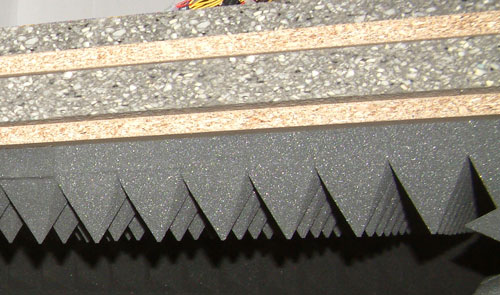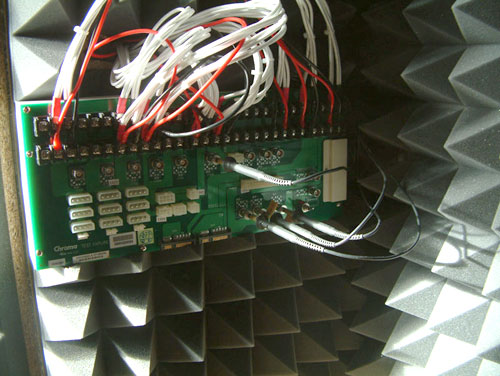Seasonic M12D 850W: DC-to-DC Perfection?
by Christoph Katzer on November 26, 2008 12:00 AM EST- Posted in
- Cases/Cooling/PSUs
Testing with the Chroma ATE Programmable Load

Our test equipment consists of two Chroma programmable DC Loads that enable us to test power supplies with an output of up to 1500W. The biggest advantage of the Chroma DC Loads is simply the high precision it provides. It can measure differences as small as 0.001V and 0.0001A, which will provide us with best-in-class results.
When programming the Chroma with specific amounts of load calculated according to the ATX norm, we are able to load power supplies to an exact percentage. We can now show results at every specific percentage needed. To get the best overview of a power supply, we load each unit with 10%, 20%, 50%, 80%, 100%, and 110% of the specified output. This is easy to calculate for a 1000W power supply: the 10% load is 100W and 110% load is 1100W. Remember that this is the amount of power the PSU delivers; due to inefficiencies, a power supply will actually draw more power from the wall.
Note: If you would like to know more about our testing methodology, equipment, and environment, please read our PSU testing overview.
We have added an additional 10% on the highest load to see how the units perform with overload. This test will be performed in all future reviews. The overload test is performed at room temperature as well as under more stressful conditions; to ensure we are not too cruel to the power supplies, we will keep the ambient temperature at 50°C in the stress test. Experience shows that many units can stand the overload at room temperature but will experience problems with higher temperature and overload together. Only the best-built units will survive this.

The Testing Environment
There is one flaw in testing power supplies with programmable loads while trying to measure the sound pressure levels at the same time. Because the programmable loads get very loud, there is no chance of hearing the power supply on the test stand. In order to make accurate measurements of the noise levels we needed a way to separate the test unit and the programmable loads. Our solution was to build a very thick box around the unit.

We concluded that a five-layer box with a total thickness of 6" (15cm) containing two layers of wood and three layers of special foam would suffice. It is designed as a box within a box. The inner box does not touch any part of the outer box, making it difficult for acoustic noise to pass through in the form of vibration. Each box is isolated on both sides with a layer of heavy foam that is normally used to insulate engines. On the inside we have an additional layer of 4" (10cm) thick pyramidal foam on every side of the box to eliminate the acoustic waves coming from the test object as well as we can.

To ensure a completely closed system we installed the printed circuit board that the connectors of the power supply are attached to inside the anechoic room/box. In other box designs, you would need to put all the cables through the wall. Unfortunately, that would result in the inside of the box not being fully isolated anymore. Our design keeps everything that needs to be connected inside of the box and maintains isolation.










45 Comments
View All Comments
sprockkets - Wednesday, November 26, 2008 - link
Very bad waveform with very high frequency components? The "waveform" exists since it cannot perfectly make a flat line voltage.Besides, the ATX12V 2.3 spec allows 120 mV ripple for all 12V lines and 50 mV ripple for the 3.3 and 5V lines. It is very well within spec, and consider that these ripple specs are stricter than previous versions of the ATX12V spec, you are going to be fine.
valdir - Wednesday, November 26, 2008 - link
Waveform exists since we are looking and measuring it... and there are good and bad ripple and noise waveforms on the DC rails, just compare with Antec Signature or Corsair 750W or Enermax Revolution or... definitively a very bad waveform.These waveforms are more like very high frequency noise covering ripple and this is not good, since on the PSU's DC rails we should see ripple and not the same noise level.
mindless1 - Saturday, November 29, 2008 - link
Actually it won't make a bit of difference in use. The day a little bit of ripple or it's frequency matters, will be the day we all start using linear PSU again.fri2219 - Wednesday, November 26, 2008 - link
Why does Seasonic insist on putting crappy ADDA fans in 150.00+ units? For the same price, they could at least source from Panasonic or Yate Loon.That ticking sound in the "heavily undervoltaged fan" (nice heavily murderaged of the englished language, there) is incredibly annoying for those of us who haven't destroyed our hearing by playing our iPods at 90db every day for the last 5 years.
mindless1 - Saturday, November 29, 2008 - link
WTF? Yate Loon is the bottom of the barrel, ADDA is mid quality. If you want a yate loon on your case wall it's not so bad but those fail pretty frequently when placed horizontally in a PSU.sprockkets - Wednesday, November 26, 2008 - link
Perhaps you can re-read page 1 where it says it uses a Sanyo Denki fan.And, what is "murderaged" spelling hypocrite?
Slash3 - Wednesday, November 26, 2008 - link
Wooshed.JarredWalton - Wednesday, November 26, 2008 - link
FWIW, that was another error with the speech-recognition. Dragon NaturallySpeaking does so well that sometimes I miss errors in dictation. Apparently, it thinks "undervoltage" is an allowable word, but I know I said "undervolted". Whatever.In case you're wondering, Christoph is not a native English speaker, but he is fluent in at least English, French, and Chinese -- besides his native tongue of German. Feel free to critique his use of a second tongue; me, I'm happy to speak English, Danish, and some German. Anyway, I do pretty heavy editing of his text to clean up the English, but errors slip through on occasion. I was pressed for time on this one (had to run off to the airport) so I didn't give the final text a second proofread.
RallyMaster - Wednesday, November 26, 2008 - link
"That's not entirely wrong, as PSUs are one of the components most people only think about when their old unit sales, or when building a new system."What does "old unit sales" even mean? Are you sure you're not saying "old unit fails?"
Spoelie - Wednesday, November 26, 2008 - link
Page 1"The PSUs are also supposed to have very tight voltage regulation in the future only Japanese manufactured capacitors."
I'm not quite sure what to make of that sentence.